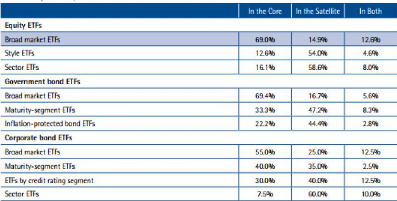5 Conclusion
The core/satellite strategy appeared in the financial world
after that the portfolio construction, provided by the modern portfolio theory
showed some issue and tended to underperform against a particular benchmark.
Most financial agents argue that investors can extract several benefits from
this portfolio construction.
My goal was to find the best way to take an advantage from the
core/satellite by using ETFs. Effectively, I think that this financial vehicle
has to take part in a core/satellite because of this features which can
overcome the few issues of this portfolio strategy like the lack of
transparency and liquidity in the satellite.
Secondly, when an investor has this kind of portfolio, he has
to accurately define his financial objectives to choose the right allocation
between the core and the satellite, and by consequent he could optimize the
return/risk pair.
Thirdly, an investor has to be aware of his tax situation. In
fact, an investor expect to get the higher after-tax return. A tax management
in his portfolio can increase the performance of this one.
This strategy has a major limit. It is not reachable to
everyone to implement this approach. The core/satellite construction can be
used only by high-net-worth investor. But even that, nowadays this strategy is
considered as one of the main driver of portfolio construction. This
dissertation allows me to discover the ETF and the core/satellite strategy.
In this first work, I have been pretty general in my
analysis to get a first approach of this environment. In a future work, I would
like to focus on the dynamic way to manage a core/satellite portfolio and
particularly the model about the DCS approach provided by the EDHEC risk
institute
23
6 Appendix
-- 1. Summary of the use of different instruments in the
core/satellite allocation

7 References
7.1 Academic references
-- Scott Welch, "The Hitchhiker's Guide to Core/Satellite
Investing", The journal of wealth management, Winter 2008.
-- Donald J. Mulvihill, "Core and Satellite Portfolio
Structure : Investments and Tax Considerations",The journal of wealth
management, Summer 2005.
-- Clifford H. Quisenberry, "Core/Satellite Strategies for the
High-Net-Worth Investor", CFA institute, December 2006.
-- Donald J. Mulvihill, "Core and Satellite : Implementation
Issues", The journal of wealth management, Spring 2006.
-- N. Amenc, F. Ducoulombier, F. Goltz, V. Le Sourd, A. Lodh,
and E. Shirbini, "The EDHEC European ETF Survey 2014", EDHEC-Risk
institute, March 2015.
-- N. Amenc, P. Malaise, L. Martellini, "Revisiting
Core-Satellite Investing - A dynamic Model of Relative Risk Management",
EDHEC-Risk institute, November 2012.
24
-- Clifford H. Quisenberry, "Optimal allocation of a Taxable Core
and Satellite Portfolio Structure", The journal of wealth management,
Summer 2003.
-- N. Amenc, F. Goltz, and A. Grigoriu, "Risk Control Through
Dynamic Core-Satellite Portfolios of ETFs : Applications to Absolute Return
Funds and Tactical Asset Allocation", The Journal of Alternative
Investments, Fall 2010.
| 

